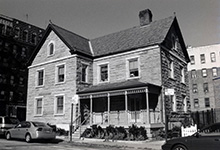I was a community organizer from 1976 to 1983 in the northwest Bronx. It was my first job after college. Until recently you may never have even heard of that job, “community organizer.” But since the Republican National Convention, it’s gotten a lot of play, thanks to Rudy Giuliani and Sarah Palin’s dissing of Barack Obama’s tenure as a community organizer in Chicago.
Throughout the 1970s, the Bronx was burning down. Arson and housing abandonment reached epidemic proportions. Entire streets and neighborhoods emptied of people, stores, cars. The only living things you might encounter in some parts of the south Bronx were packs of feral dogs. By some estimates, the abandonment was moving north at the rate of 10 blocks a year. People in the northwest Bronx looked anxiously south at the flames moving north. Some of our neighborhoods began to have the same troubles: housing in crisis, serious fires, boarded up buildings and empty lots. (If you didn’t live here then or you’re too young to remember, just Google “Bronx fires 1970s” for disturbing pictures and stories of that time.)
But just what is the connection between those fires in the Bronx and community organizing? What does the kind of work done by one US senator and hundreds of people like me have to do with the burning of the Bronx?
Organizing people throughout the northwest Bronx is what stopped the fires and turned things around. It’s what got thousands and thousands of people together across the northwest Bronx to demand and get improvements to dilapidated housing, to live on safer and cleaner streets, to have a say in the quality of life in their neighborhoods.
In a recent New York Times article, the Center for Community Change says that organizing is about listening. And it’s about interpreting for people — sort of like translating a foreign language. We listened to people’s problems, their experiences of no heat and hot water and dirty streets and dangerous parks and low performing schools. And we helped them translate those problems into issues and demands for improvements from landlords, bankers, politicians, city commissioners and government regulators.
Organizers are the staff people, the support system that “regular” people wouldn’t have otherwise. Public officials and bankers and landlords have people who work for them to help with research and lobbying, fund-raising and policymaking. Community organizers work full time on issues, researching and investigating them to help people really understand what’s behind the problems they face. By working through problems together, organizers help people realize that their instincts about what’s right and wrong, what’s fair and just, are on target. They learn how neighbors they didn’t know or trust are similarly affected and willing to fight for better housing, good jobs, safer streets, better schools and neighborhoods. People learn how to hold meetings and get results, how to hold the right parties accountable for their part of the solution. People learn to speak for themselves and their community. They learn about power and how to use it for the common good.
So yes, because of community organizers, the Bronx stopped burning. The quality of life in our neighborhoods stabilized and people learned about real democracy at the grassroots level.
It’s one of the best jobs I’ve ever had.
Lois Harr worked as an organizer for the Northwest Bronx Community & Clergy Coalition. She has lived and worked in the Bronx her whole life. She resides in Bedford Park with her husband, John Reilly, a former community organizer.




